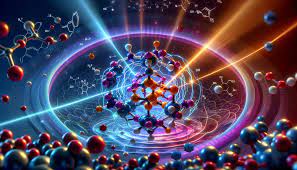Molecular Spectroscopy: A Wild “Industrial” Revolution Making Waves in Food Authenticity
- Nelson Quarshie Attipoe
- Jul 9, 2024
- 3 min read
Updated: Nov 6, 2024
In today's global market, where consumer demand for high-quality, authentic food products is at an all-time high, food fraud is gradually creeping and making its way into the food sector. Meat, fish, coffee, tea, mushrooms, and spices – foods celebrated for their nutritional prowess and sensory delights – have become prime targets of food fraud and tampering with primary aims of economic exploitation. Molecular spectroscopy however is now presenting agricultural potentials and advances in the authentication of foods.
The Spectral Sentinels
Imagine a world where a simple beam of light could unveil the deepest secrets of your food – its origin, composition, and authenticity – all in a matter of seconds. This is not science fiction; it is the innovative reality of molecular spectroscopic techniques. These methods are rapidly making conventional analytical approaches obsolete, offering an array of advantages: cost-effectiveness, minimal sample preparation, and the ability to fingerprint food quality with unprecedented precision.
A deep dive into spectroscopy reveals four techniques that stand out and are making waves in food quality:
1. Near-Infrared Spectroscopy (NIRS): The Sherlock Holmes of Food Analysis
NIRS has emerged as a versatile and non-invasive technique, capable of examining the molecular makeup of foods. From identifying the geographical origin of your early morning coffee to ensuring the pork from your favourite pork joint is the real deal. In simple but factual terms, it can be said that NIRS is revolutionizing food authentication.
2. Infrared (IR) Spectroscopy: The Compositional Composer
IR spectroscopy writes a symphony of molecular vibrations, providing a detailed compositional analysis of foods. It is a particularly efficient way of detecting subtle adulterations in spices and herbs, ensuring that the creations of your culinary imaginations are built on authentic foundations.
3. Hyperspectral Imaging (HSI): The Food Photographer with X-ray Vision
This technique takes food analysis to a whole new dimension, literally. By combining spectral and spatial information, it creates a vivid picture of food quality, detecting everything from freshness of fish to hidden contaminants in grains.
4. Nuclear Magnetic Resonance (NMR) Spectroscopy: This Molecular Detective NMR explores the atomic structure of foods, unravelling complex molecular mysteries. It can authenticate high-value products like premium teas and exotic mushrooms, which ensures that what is on the label truly matches what is present in the package.
The Significant Others
While these four techniques steal the spotlight, the valuable contributions of UV/Vis spectroscopy, proton NMR (1H-NMR), and Raman spectroscopy cannot be overlooked. These methods play crucial supporting roles which offer complementary data that paints a more complete picture of the quality of food.
The Chemometric Support System
Behind every great spectroscopic technique lies an intricate support system of data analysis. Enter chemometrics – the mathematical and statistical techniques that transform complex spectral data into meaningful insights. From Principal Component Analysis (PCA) for data visualizations and pattern recognitions, to Partial Least Squares Regression (PLSR) for quantitative predictions, chemometrics is the silent hero in the fight against food fraud.
Challenges That Arise
As great as the spectroscopic methods are, they have their own downsides. One of the most significant challenges lies in their reliance on conventional reference data for quantitative analysis. This dependence can sometimes lead to a case of "garbage in, garbage out", if the reference methods themselves are flawed or inconsistent.
The Future is Handheld
Imagine again, a world where food inspectors wield tricorder-like devices, scanning products on-site for instant quality assessment. This sci-fi dream that seemed improbable a few decades ago is rapidly becoming a reality with the emergence of handheld spectroscopic devices. These portable devices are set to revolutionize food quality control, bringing lab-grade analysis to the field, factory floors, and even in the nearest local supermarkets in our neighbourhoods.
So What Next?
As we stand on the brink of this spectroscopic revolution in food quality management, the possibilities are as exciting as they are numerous. From ensuring the authenticity of your morning coffee to safeguarding the purity of “life-saving” medicinal herbs, molecular spectroscopy is reshaping our relationship with food.
But the journey does not end here. As researchers and innovators, we must continue to push the boundaries of these technologies, striving for more advancements. We need to develop more robust models and find innovative ways to overcome current limitations.
The future of food quality has already set sail for further advancements. So, the next time you savor a perfectly spiced dish or sip a cup of premium tea, remember – there's a good chance that spectroscopy played a role in ensuring its quality and authenticity. With that, welcome to the age of spectral gastronomy!
For More, Read This Paper
Zaukuu, J.-L.Z.; Benes, E.; Bázár, G.; Kovács, Z.; Fodor, M. Agricultural Potentials of Molecular Spectroscopy and Advances for Food Authentication: An Overview. Processes 2022, 10, 214. https://doi.org/10.3390/pr10020214
Did you find this post useful?
YES
NO





コメント